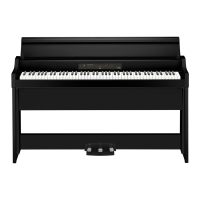14
theirfactorydefaultseings.Ifyouwanttoerasetheper-
formancedatayou’verecorded,referto“Song:Deleteall”
on page 13.
Before continuing with this procedure, make sure that you
wanttorestorethefactorydefaultseings.
Select function “
”, and then press the Record but-
ton to perform the operation.
The display indicates that the operation is being performed.
Whentheparametersarereset,donotturnothepia-
no while “000” appears in the display.
About MIDI
In order to transfer MIDI data, a pair of commercially avail-
able MIDI cables is required.
The MIDI Out of the G1/G1 Air sends data to the MIDI In
of the other MIDI Device. The MIDI In of the G1/G1 Air re-
ceives MIDI data being sent from the MIDI Out of the other
device.
Fordetailsonthedatathatcanbetransmiedandreceived,
refer to the following compatibility table and the MIDI im-
plementation chart.
Sounds and Corresponding Program Change Numbers
Abbreviation
PC
Abbreviation
PC
Abbreviation
PC
0 10 20
1 11 21
2 12 22
3 13 23
4 14 24
5 15 25
6 16 26
7 17 27
8 18 28
9 19
Local On/Off
On:With the Local On seing, playing the G1/G1 Air’s
keyboard produces the sounds of the performance as
well as transmits MIDI data.
O: With the Local O seing, playing the G1/G1 Air’s
keyboard does not produce the sounds of the perfor-
mance;MIDIdataisonlytransmied.
Program Change Filter
On: The sending and receiving of MIDI Program Change
information is disabled.
O: MIDIProgramChangeinformationwillbesentand
received.
Control Change Filter
On: The sending and receiving of MIDI Control Change
information is disabled.
O: MIDIControlChangeinformationwillbesentandre-
ceived.
Multi-Timbral
The G1/G1 Air can operate as a 16-part multi-timbral sound
module when controlled from an external MIDI device
On: The G1/G1 Air can be used as multi-timbral sound
module via an external MIDI device.
O:
The G1/G1 Air cannot be used as multi-timbral sound
module.
Additional Functions and Descriptions
*1
Turning on/off reverb
ReverbcanbeturnedonorobyholdingdowntheFUNC-
TIONbuonandpressingtheG.PIANObuon.
*2
Keyboard Touch Control Curve
02
01
03
05
Loudness
Quiet
Quiet
Loud
Playing strength
04
Display Touch sensitivity
01
Light. Loud notes can be produced even by playing
lightly.
02
Normal.(defaultseing)
03
Heavy. Loud notes can be produced only by play-
ing very hard.
04
Stable. Sensitivity variations are reduced, and a
relatively stable sound is produced.
05
Steady. Steady notes are produced, like with an or-
gan, regardless of the force used to press the key.
*3
Temperament types
Display Temperament
01
Equal temperament (default seing):
Spacing all semitones at equal pitch intervals,
this temperament is the most widely used.
02
Pure temperament [major]: Major chords in the
key (C) are perfectly tuned.
03
Pure temperament [minor]: Minor chords in the
key (C) are perfectly tuned.
04
Arabic: This scale includes the quarter-tone inter-
vals used in Arabic music.
05
Pythagorean: This ancient Greek scale is espe-
ciallyeectiveforplayingmelodies.Itconsistsof
perfectfths;however,otherintervals–themajor
third in particular – is out of tune.
06
Werckmeister: The Werckmeister
III
scale was
created in the later Baroque period to allow rela-
tively free transposition.
07
Kirnberger: The Kirnberger
III
scale is used main-
ly for tuning harpsichords.
08
Slendro scale: This is an Indonesian gamelan
scalewithvenotesperoctave.
09
Pelog scale: This is an Indonesian gamelan scale
with seven notes per octave.
About stretched tuning
In order to produce the most natural resonance, piano
sounds use a “stretched tuning” that makes the notes of the
lower rangeslightlyaer than equal temperament,and
the upper range slightly sharper. This is how an acoustic
piano is normally tuned by professional tuners.
*4
Resetting the parameters
This procedure will not delete the performance data that
you’verecorded,butwillreturnallparameters/functionsto

